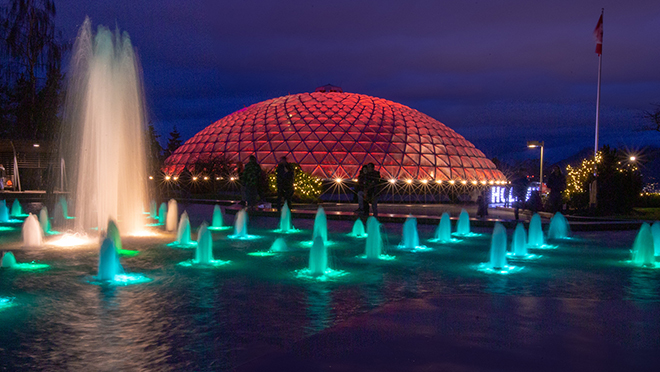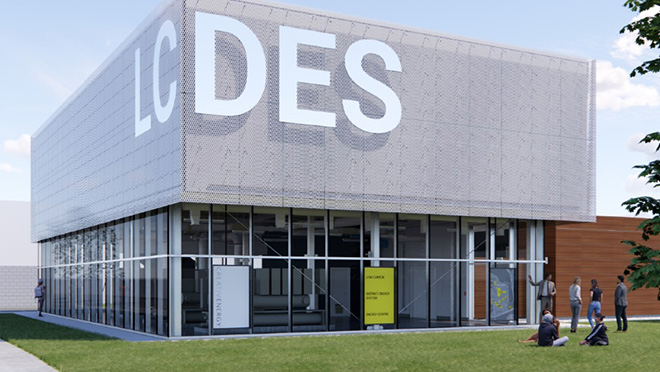Campus decarbonization makes UBC a Clean Energy Champion
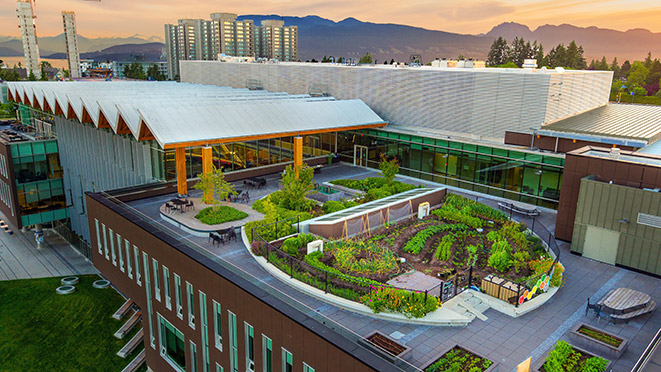
Efficient buildings, bioenergy project, put university on an aggressive path
Part of a series on BC Hydro Clean Energy Champions: businesses, homes, and institutions – large and small – recognized for their reduction in their reliance on fossil fuels.
When your job is so tied to sustainability, it makes sense that a Vancouver downpour doesn't stop you from riding your bike 35 minutes to work.
"Yeah, it was a little uncomfortable, but I've got the full gear, so it's all good," says John Metras, who rides regularly from his Mount Pleasant home to his job as associate vice-president responsible for UBC facilities at the University of British Columbia.
It also had to be a tad uncomfortable for UBC to adopt its first Climate Action Plan goal, back in 2010, of a 67% reduction in greenhouse gas emissions by 2020, en route to net zero by 2050. But like Metras and his waterproof booties, UBC seems equipped to stay on track for a renewed goal of an 85% reduction in emissions from campus operations, by 2030, over 2009 levels.
They're doing this, even as their Vancouver and Okanagan campuses grow, by operating what they call a "living lab". And the lab isn't so much about experimenting as it is about planning and delivering on emissions reductions.
"Going back to 2010, when our president at the time Stephen Toope announced pretty aggressive targets for the university, we were trying to set a leadership tone, and hoping that others would take it up," recalls Metras. "We developed a road map for how we would do it, with some technical underpinning to what we were targeting. From there, we implemented a number of large-scale projects to achieve those targets."
Here are a few of the big steps UBC has taken so far:
- Steam to hot water conversion (10,600 tonnes CO2e reduction)
UBC's new 45 megawatt Campus Energy Centre is a hot water district energy system that replaced the campus' 90-year-old steam system. This switch improved energy efficiency by over 24%, reduces GHG emissions by 20%, and reduced operational costs by $5.5 million per year. - Bioenergy facility (8,400 tonnes CO2e reduction)
UBC's Bioenergy Research and Demonstration Facility (BRDF), uses clean wood waste – from the likes of furniture factories and tree pruning – to produce fuel that powers a boiler that will eventually generate 70% of the hot water needed for the campus' district energy system. - Building tune-ups (4,300 tonnes CO2e reduction)
UBC's Building Tune Up program has retrofitted and recommissioned many new and existing buildings on campus, complete with a strategy improve building temperature, lighting, and ventilation controls to match occupancy, in part by shutting systems off when they're not in use. Heat pumps are also a big part of that strategy.
The push to green, and carbon taxes, spur innovation
There is no secret sauce to UBC's success in delivering on CO2 reduction goals, not just committing to them. It's more a blend of the institution's quest to become the world's greenest university, and the practicality of avoiding carbon taxes down the road.
The energy savings produced by various projects at UBC, such as the use of wood waste to produce bioenergy, have added up to significant savings to help pay back the capital costs of such projects. But the math going forward is less about energy savings and more about fighting climate change.
"The big challenge moving forward, particularly with electrification, is that there aren't the same savings involved," says Metras. "The financial gains are more around the future cost of carbon – as a public institution in B.C., we're obliged to be carbon neutral. And if we don't do it through technical means, it would be through the payment of carbon taxes through carbon offsets.
"If we were to continue using natural gas to heat the campus, there would be a significant carbon tax associated with that."
None of this happens, of course, without UBC embracing the role as sustainability innovator. It sees itself as a "Living Lab" that works with BC Hydro and other utilities to assess the best ways to avoid gas use and improve the efficiency of operations on both the Vancouver and UBC Okanagan campuses.
"The concept of the Living Lab is the use of the university's campus and physical infrastructure as a test bed to explore, demonstrate and develop new technologies, ideas and solutions to advance sustainability and address climate change," he says. "It involves a collaboration between researchers, students, university operations staff, and external partners to solve real operational challenges on the campus."
One of UBC Vancouver's two district energy systems connects 160 buildings on the Vancouver Point Grey campus through 14 km of district energy hot water piping. It connects to both the waste wood facility and the current natural gas heating plant. The other district energy system is for the campus neighbourhood, where new housing is being developed with a target of getting at least 60% of energy from alternative sources.
At each building, heat exchangers transfer the heat from the DES into separate heating or hot water systems within the building. The hot water is then circulated through the building to radiators and heating coils for space heating or through separate domestic hot water systems to taps. Some buildings are not connected to the DES system, and are instead use a separate natural gas or electric system – increasingly through air-source heat pumps – within the building to support heating and domestic hot water.
Many UBC students are getting hands-on experience in sustainability. Units and programs across the university engage in living lab style research and activities, such as the UBC Farm, which supports a number of living lab projects on biodiversity and agricultural innovations, and the biomass energy plant that houses the Biorefining Research and Innovation Centre.
Metras points to the example of a grad student who developed a system that uses wifi to determine space occupancy in buildings: information used to control heat and lighting systems to reduce energy use. The student has started a company to take such ideas into the broader community.
"As a leading public research university, we feel we have a responsibility to leverage our academic and operational capabilities to try to address these problems and share knowledge beyond the campus," says Metras.
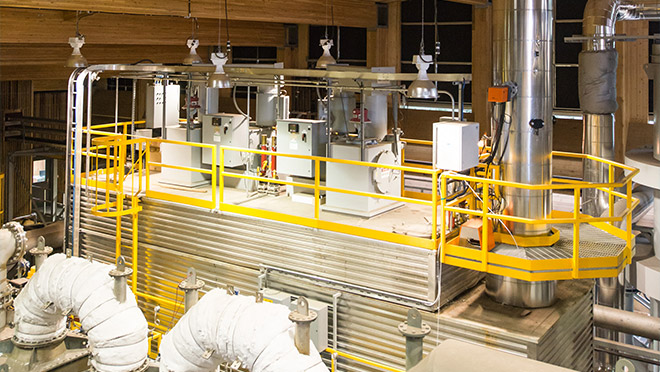
Bioenergy facility uses waste wood to heat campus buildings
Since 2012, two to three truckloads of ground and chipped waste wood per day have gone into the production of synthesis gas (syngas) that replaces natural gas used to heat UBC's campus buildings. It all happens at UBC Vancouver's Bioenergy Research and Demonstration Facility (BRDF), a project that's a North American first and which reduces the university's reliance on fossil fuels.
"We've had that facility in operation for 10 years and it has had a significant impact in terms of reduction of our carbon footprint," says Metras. "What really makes it sustainable in our view is that it's utilizing waste that would otherwise go into the landfill and biodegrade over time, releasing carbon through the natural degradation process.
"We're using a product that otherwise would be buried. It's part of our focus on diversifying our fuel sources moving forward."
How much longer can UBC count on a regular supply of waste wood? Metras says there's a long-term contract with the wood supplier, and that so far, there's been no shortfall of waste wood supply, mainly from wood manufacturing and landscaping operations.
"We use a local firm that provides us with the right mix of wood that's free of contamination and with chips that are the right dimension and size for optimum combustion. And we've had a grad student do a living lab project to identify the optimal mix and size of those wood chips."
After an expansion of the bioenergy facility that aims to triple its heat output, Metras says the expectation is that the plant will allow the UBC Vancouver campus to achieve an overall 60% reduction in GHG emissions compared to the 2007 baseline.
But heat pumps are seen as vital to further reducing the energy needs at the UBC Vancouver campus.
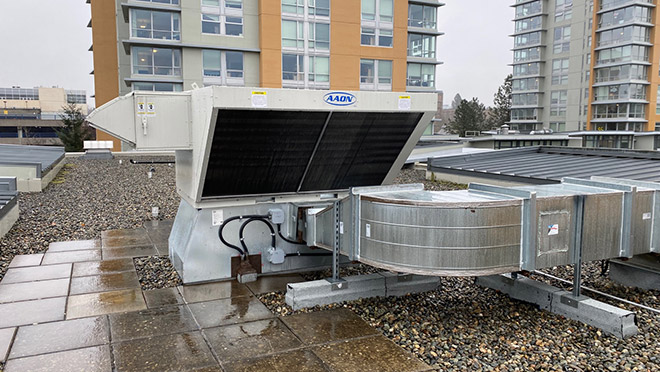
Heat pumps abundant at UBC, trimming GHGs and providing cooling
Throughout the UBC campus, heat pumps play a major role, with 15 buildings now using heat pumps and heat pump chillers to help cut emissions – by an estimated 2,000 tonnes of GHG reductions per year – while providing year-round comfort.
"Wherever heat pump technology is viable, we use it as a first step," says Philip Brussé, associate director of Energy and Water Services' Energy Conservation and Innovation within UBC Facilities. "We use a heat pump solution first and, as a backup we always connect the District Energy System (DES) for those times when the heat pump technology can't supply what we need in a building."
The viability of heat pumps depends on variables including whether a building requires cooling, to the availability of air flow into and out of a building. And in keeping with UBC's Living Lab concept, the university's energy group is learning a whole lot about how to deal with the complexities of efficiently integrating heat pumps into an integrated system with the DES.
Brussé says he has recruited a group of experienced engineers specifically to help deal with everything from the commissioning of heat pumps to ongoing tweaking of controls. And his advice for anyone working with such complex systems is to get a top-notch consultant involved early in the design stage of a heat pump installation, and make sure they work closely with a qualified controls vendor.
"After that, you really need to have a sound, qualified commissioning agent," he says.
Echoing the importance of getting commissioning of a system right is Debra Eng, who as UBC's ancillary energy manager is responsible for overseeing energy systems in student housing at UBC. Cooling needs are on the increase – many students in older buildings without cooling still resort to plugging in portable air conditioning units in summer months.
"Cooling wasn't really a requirement when a lot of these building were built, but where we have the opportunity in our newer buildings, we are directly providing cooling into rooms through heat pumps," she says, then adds with a laugh: "But we haven't really let people know that we have the ability to cool now in certain buildings, because not everybody has it."
UBC recently used CleanBC incentives to add rooftop heat pumps at two Marine Drive residence buildings, and are looking to also add them to two more Marine Drive residences. Eng says that the heat pumps have allowed UBC to stop using natural gas to heat the two buildings, but engineers are still learning how to find the most efficient operation of the heat pumps.
"It's an expensive piece of equipment, and you have to make sure that it's operating optimally and as designed," she says. "So I think the commissioning aspect is probably the most important part in making it operate as intended. You don't want to be using a backup source regularly, which would be less efficient and more costly."
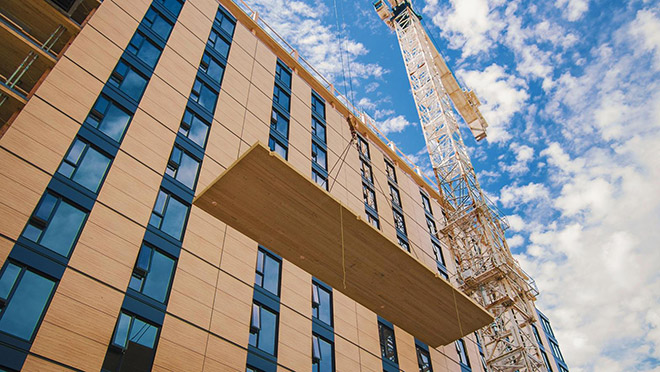
Energy and emissions reductions central to green building strategy
Since 2008, all new campus construction and major renovations at UBC have been mandated to be Leadership in Energy Environmental Design (LEED) Gold certified.
Sometimes building sustainability happens from the ground up, such as with the 18-storey Tallwood House, one of the tallest hybrid – wood and concrete – buildings in the world. The innovative building uses prefabricated cross-laminated timber floor panels, which are supported on glue-laminated timber and parallel strand lumber columns.
One of the wonders of Tallwood House, home to more than 400 UBC students, is that its prefabricated components allowed the building to be constructed at a two-storeys-per-week pace. It's now one of 23 new LEED-certified buildings on the campus.
"We've learned that the amount of embodied carbon in concrete buildings is quite significant, and that wood has a much lower carbon footprint," says Metras. "So there's a real benefit to utilizing mass timber in building construction. We now have more than 20 buildings on our Vancouver campus that incorporate mass timber as a structural material in some way."
But UBC's green building plan isn't all about building new. Many structures, including the one that houses UBC's electrical and computer engineering department, have been painstakingly updated to deliver on both better use of space and sustainability.
Built in the 1960s, the Macleod Building underwent a $51 million renewal that delivered on seismic upgrades, a high-performance building envelope, and new, efficient mechanical and lighting systems.
"We basically stripped it down to the bare structure for the upgrades," says Metras. "We're getting 40 to 50 years of extended life out of an old building without knocking the original structure down and incurring the cost of additional embodied carbon in the reconstruction."
